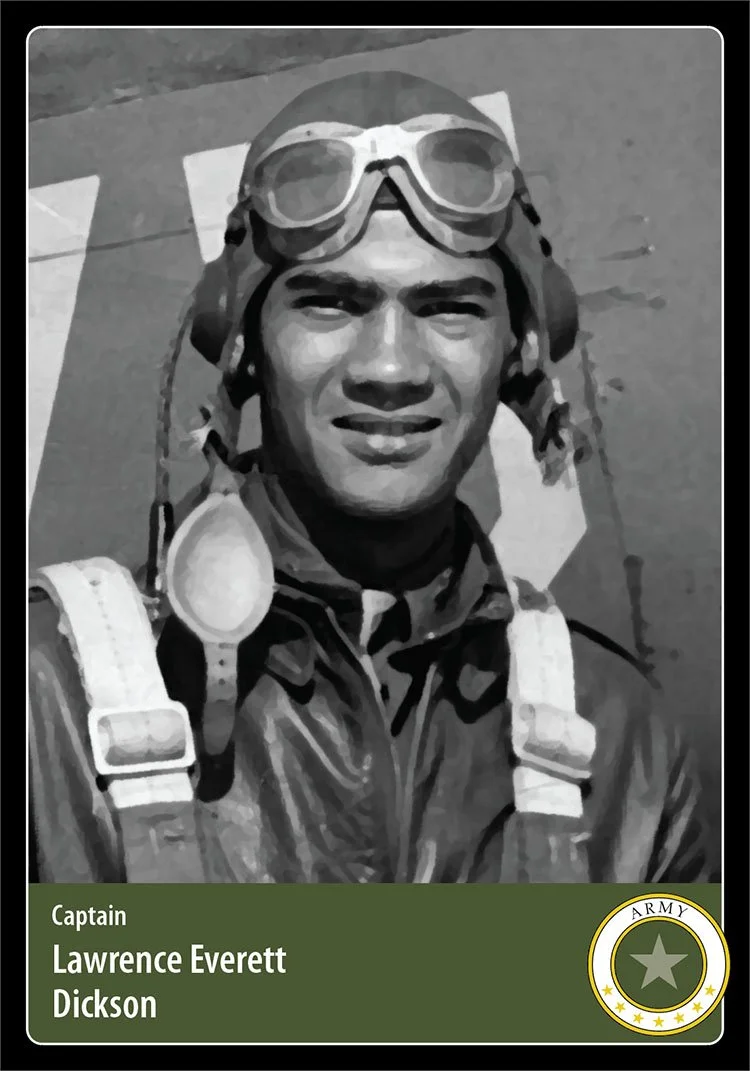Hero Card 76, Card Pack 7
Artist’s rendering by Craig Du Mez, from original photo
Hometown: New York (The Bronx), NY
Branch: U.S. Army (Air Forces)
Unit: 332nd Fighter Group, 100th Fighter Squadron
Military Honors: Distinguished Flying Cross, Air Medal, Purple Heart
Date of Sacrifice: December 23, 1944 - KIA near Hohenthurn, Austria
Age: 24
Conflict: World War II, 1939-1945
Lawrence Everett Dickson was born in Society Hill, South Carolina on May 31, 1920. Ten years later, his family moved to Manhattan, New York, where he worked as a file clerk. In December of 1941, Dickson married Phyllis Maillard. By then he was employed as a chemist, and in July of 1942, their daughter Marla was born.
Dickson joined the Army Air Force and completed flight training at Alabama’s Tuskegee Airfield in March of 1943. As one of the famed Tuskegee Airmen—the first black pilots who served in World War II (1939-1945)—he was assigned to the 332nd Fighter Group, 100th Fighter Squadron.
Tuskegee pilots in the 332nd flew P-51 Mustang fighters, nicknamed “Red Tails” because their chosen unit identification on the planes included red-painted tails and noses.
The heroic performance of the Tuskegee Airmen in combat captivated the nation and was instrumental in the eventual racial integration of the U.S. armed forces. Desegregation wouldn’t take place until July of 1948, when President Harry Truman signed Executive Order 9981, which read, in part:
It is hereby declared to be the policy of the President that there shall be equality of treatment and opportunity for all persons in the armed services without regard to race, color, religion or national origin. This policy shall be put into effect as rapidly as possible, having due regard to the time required to effectuate any necessary changes without impairing efficiency or morale.
After additional training at Selfridge Field in Michigan, Dickson’s 100th Fighter Squadron was deployed to Europe in December of 1943, stationed at Ramitelli Air Field in Italy.
Lawrence Dickson quickly became an accomplished flyer, having completed 67 successful missions and earning a Distinguished Flying Cross. He was promoted to the rank of Captain.
On his 68th mission on December 23, 1944—escorting an unarmed photo-reconnaissance plane toward Nazi-occupied Prague, Czechoslovakia—Dickson radioed that his Mustang was experiencing engine trouble, and he’d have to turn back to base at Ramitelli. On the trip back, his plane crashed in the mountainous region near the border between Italy and Austria.
After his P-51 went down, his wingmen couldn’t find any sign of Dickson, a parachute, or plane wreckage in the snowy mountains. Lawrence Everett Dickson was listed as Missing in Action (MIA). After multiple unsuccessful searches, in 1949 the U.S. military declared Dickson’s remains to be non-recoverable.
It would take another 73 years for the crash site to be located and confirmed. In the summer of 2017, the Defense POW/MIA Accounting Agency (DPAA)—in cooperation with the University of New Orleans and Austria’s University of Innsbruck—conducted an excavation of a crash site believed to be Dickson’s plane. Capt. Dickson’s remains were later identified through DPAA laboratory analyses.
Among the items recovered from the crash site was a 14-karat art deco ring with an aqua-colored stone, inscribed “P.D.” (Phyllis Dickson) with a heart with an arrow through it, and “L.E.D. 5-31-43.” May 31 of 1943 was Dickson’s 23rd birthday. Also recovered was a small cross, and part of his harmonica.
The recovered items were presented to Capt. Lawrence Dickson’s daughter Marla (Andrews)—who was just two years old when her mother Phyllis received notification that Lawrence was missing in action.
On March 22, 2019, at age 76, Marla finally saw her father laid to rest. In a ceremony at Arlington National Cemetery, across the Potomac River from Washington, D.C. (Section 60, Site 11831), four Air Force jets roared overhead in a solemn farewell to the Tuskegee Airman, Capt. Lawrence E. Dickson.
Sources
Artist’s rendering, from original photo: Craig Du Mez
VA News: Army Air Force Veteran Lawrence Dickson
U.S. Army: Tuskegee Airman posthumously honored after decades MIA
National Parks Service: Executive Order 9981, Desegregating the Military
Defense POW/MIA Accounting Agency: Tuskegee Airman Accounted For From World War II (Dickson, L.)
Smithsonian Magazine: Remains of Tuskegee Airman Found in Austria
Air Force Times: Remains of WWII pilot are first of the 27 Tuskegee Airmen still listed as MIA to be identified
History.com: Tuskegee Airmen
Salisbury Post: Tuskegee Airman’s funeral reminds daughter of life she might have had
Burial Site: Find a Grave





